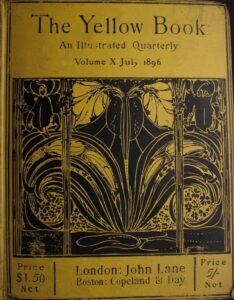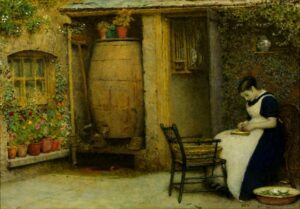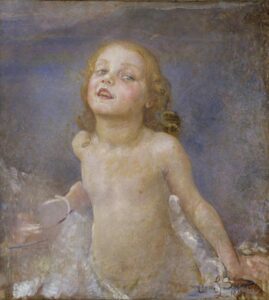“She grew to look more like a restless, untamed spirit every day”: Gender Roles and the New Woman in K. Douglas King’s “Lucretia”
© Copyright 2017 Kody McConkey, Ryerson University
K. Douglas King and Her Tale of Lucretia
In my exhibit, I will be analyzing the short story “Lucretia”, published in the 10th edition of The Yellow Book in July 1896. The story is written by author K. (Katherine) Douglas King. It is a realist drama that touches upon subjects of marriage as a career for women in the 1890s, gendered expectation of wives, and the push for a more independent societal view of women.

This edition of The Yellow Book includes many text related to the theme of relationships between man and woman, including “An Idyll in Millinery” and “The Invisible Prince”. “Lucretia” focuses on the life of a working-class woman, named Lucretia, who is frequently described as being stuck within the life of a typical wife. Her husband is a man of little passion and confidence, and she is quickly becoming infatuated with her husband’s superintendent. Luce is frequently described by the narrator as being “abnormal in the soul” (King 224) and having “sufficient imagination to realise freedom” (225), however she is trapped in a socially expected marriage and can only ease the resentment towards her own life through having an emotionally stirring affair. Katherine Douglas King, author of “Lucretia”, also wrote many other short stories. Including “A Little Black Sheep”, a story that focuses around a woman named Mary Ann who is an under-servant to a rich family.
The Common Working-class Woman of the 1980s
A working-class woman in the Victorian era regularly had a very well-known type of marriage. The loveless marriage, where the wife is simply viewed as the domestic partner, who has a job that is expected of her (Phegley 9). The wife was also seen as having a sexual duty to the husband, and the evidence of any sort of sexual desires as being a corruption (Murdoch 166).

CC-BY-NC-ND 3.0 (Unported), Public Domain. http://www.tate.org.uk/art/work/N03526
The showcasing of the effects this marriage can have, became a very popular topic for Victorian literature. However, by doing so, authors also encouraged deviation from the socially expected arranged marriage (Phegley 12). By the late 19th century, it was commonly seen as necessary for a woman to marry within her life, just as common as it was for illegitimate marriages to be shunned upon (Murdoch 106). Lucretia is within the working-class, and is a result of this rise in intrigue; into the strife of a women. A main point of this struggle being the expected gender roles and division of labour. As mentioned, women had a job: to provide meals for the family and keep the children in line (Murdoch 116), which “Lucretia” demonstrates. However, it also introduces a commentary on the cultural topic of the intellectually and creatively constricted wives. Women who must commit to marriage to support themselves because “their options for supporting themselves were limited” (Bomarito, Whitaker). However, there were women who refused to conform, and began a movement of the “New Woman”—a woman who refuted the common ideas that a wife must live as being economically and mentally dependent on a man (Bomarito, Whitaker). “Lucretia” contains a lot of perspective on the treatment of wives in the Victorian era which raises questions on how unconventional her actions really were, and if they conformed to a woman in her circumstances.
Motherhood, Affairs, and the Emergence of the New Woman
It is intriguing to wonder if Lucretia herself would have been, or already defines the idea of a New Woman within her circumstances. Given the gender roles she is expect to fill and the creativity the narrator claims she possesses, she is in a situation the New Woman was typically in. With the theme of unfulfilling marriage, and many examples of the diverse relationships between men and women, this edition of The Yellow Book was particularly keen on contradicting standard marriage expectation by presenting many different situation in which a couple may find themselves. However, with stories like “Lucretia”, there are certain culturally expected themes present as well. My analysis will show that Lucretia is an example of a very common type of woman in the 1890s, who was often found silenced or deterred from her possible creative path. Mainly by the expected marriages and roles that a woman was pressured to uphold. Alternatively, it will also be shown how “Lucretia” is not a full fledge New Woman story. The author is simply hinting at something much larger than the narrative of “Lucretia”—that being the lack of resources for driven women in the 1890s. However, she does still hang on to certain conservative ideas in the story itself.
Some would argue that women were tasked with remaining “physically, mentally, and spiritually fit because the future of the race would depend on them” (Purdue 124), that future being their children. There was a somewhat general census that the New Woman should be less focused on the aspect of motherhood (Purdue 125). However, other New Women writers, such as Sarah Grand, believed motherhood to be an aspect of womanhood to be embraced and used in an empowering manner (Purdue 126). In “Lucretia”, Luce is often portrayed as seeing her motherly duties to be required, but unfulfilling. Lucretia does, however, deeply care for her daughter, Molly. When Lucretia’s sister come to remove the children from the atmosphere of scandal in the household, Lucretia begs her sister “God’s sake not [Molly]—out of any of ’em!” (King 237). This shows a rift within Lucretia: she does feel an expected motherly love towards one of her children, but feels apathy towards the rest of her children. Again, displaying a hint of conservative ideas within the story.
Many working-class women hardly had any education at all in pregnancy (Murdoch 166), they were simply used by men to complete sexual desires. Murdoch explains that an ideal woman was often seen as one of virginity and chastity, to have sexual relations before marriage was of great sin (165). One who thought very little of sexual fantasies, but mainly of her motherly duties (Murdoch 166).

Reversely, Luce’s husband does not treat her in any dominant sexual manner, however the abuse of privilege and sexist remarks comes mainly from Luce’s lover, Caldwell. He is described as having the eyes that “as the representation of all manly and persuasive power” (King 228) while gazing upon Luce, showing that the way he is presented is as an alpha male. He is also proven to overstep sexual boundaries when he kisses Molly. She slaps him in response, but he replies with the wager that in five years Molly “won’t refuse a man’s kiss” (King 230). Though it is a demonstration of New Woman ideology by leaving her husband for her own needs, the fact that the new man she is with is much more demeaning is more of a, albeit blunt, conservative view.
A Deeper Look at Luce
Lucretia is described by the narrator as one to give “vent to absurd and impossible aspirations” (King 223) and of harboring “intense distaste for the work at hand” (King 225). As mentioned earlier, women were restricted in their career paths. The narrator of this story seems to be vehemently insinuating that Luce feels completely bored with her life as a wife, and that she has the mind for so much more. There is a very interesting passage in the story:
“If she had been ‘born a lady’ she would have read ‘advanced’ books, and become an ‘advanced’ woman. Also, she would have refused the John Burnetts of her own station who sought her hand in marriage. She would have known she had a higher duty to perform than to marry a mere man, and would have acted, generally, according to her convictions—which were of a subjective nature” (King 224).
This passage is the narrator once again implying the class that Lucretia was born and is stuck in, that of the middle or upper-class. Had she been in a higher class, she could have read more books and gotten a better education to enhance her creative intellect. She also would have been able to marry someone she felt more emotion towards, compared to her husband, John. It is clear that even the author created Lucretia as a character who was meant for much more than what she had in her life.
Why Write New Woman Fiction?
The New Woman movement of the 1890s gives context to what many female authors attempted to project through their writing. Many authors had the goal to “attack marriage, to break the bonds of censorship…, and… to argue from various points of view, the feminist case” (Cunningham 178). It can be argued that Katherine King is attacking the construct of marriage with her taboo story of a woman having an affair. As the New Woman gave way to a large movement, many Victorian writers tribute their works towards the New Woman cause (Cunningham 178). Many center characters were women who refused or denounced the common female roles of their time period (Cunningham 178). Though Lucretia does not openly denounce the constraints of marriage at any point, the narrator is very sure of Lucretia’s overall potential outside of it. New Woman fiction was often separated into two categories, coined purity school and neurotic school (Bomarito, Whitaker). While purity school dealt more with fictional heroines that were more delicate victims of cultural inequalities, neurotic school was one to use very headstrong heroines in order to get their point across (Bomarito, Whitaker). While Lucretia herself seems to be more of a purity school figure, the overall tone of the short story is much more insistent on a neurotic school tone. Due to the fact that Lucretia is never vocal about her boredom with marriage, it is possible she could come across as a simple wife caught in a love affair. However, it is clear that the intended tone is one of critical commentary on the expectation of society. With hopeless passages such as “…she has neither the leisure nor the means wherewith to cultivate the abnormal in her soul,” (King 224), and seemingly sarcastic remarks such as “Naturally, the source of these troubles was a woman” (King 223), King’s criticism is much more apparent.
Conclusion
Katherine King clearly had a message to send through the story of strong-willed Lucretia. Though Lucretia herself seems to be unaware of her higher purpose, the author does make it known. Stuck in a working-class, loveless marriage was not uncommon for a woman like Luce, and King wanted it to be known. King does not completely shape Lucretia as a New Woman, however, she instead utilises the narration as an opportunity to project New Woman ideas into her story.
Trapped in her small town, living on the side of the railroads, Lucretia was clearly meant to represent a censored Victorian woman who needed to do so much more than have marriage as a career. King wrote “She wanted something. She did not know what she wanted” (226), which represents quite well how many women lacked the opportunity to do anything of creativity or independence with their lives. Leaving them to grow restless and unhappy. The New Woman movement took this feeling as motivation to show the world how they rejected the gender roles given to them. Many women, even today, could most likely relate to Lucretia on some level. Making King’s short story a timeless text that does not lose its impact.
- Bomarito, Jessica, and Russel Whitaker, editors. “The New Woman in Nineteenth-Century Literature.” Nineteenth-Century Literature Criticism, vol. 156, 2006. Gale, http://go.galegroup.com.ezproxy.lib.ryerson.ca/ps/retrieve.do?tabID=T001&resultListType=RESULT_LIST&searchResultsType=SingleTab&searchType=AdvancedSearchForm¤tPosition=4&docId=GALE%7CH1410001463&docType=Topic+overview%2C+Critical+essay&sort=RELEVANCE&contentSegment=&prodId=LitRC&contentSet=GALE%7CH1410001463&searchId=R14&userGroupName=rpu_main&inPS=true.
- Cunningham, A. R. “The ‘New Woman Fiction’ of the 1890’s.” Victorian Studies, vol. 17, no. 2, 1973, pp. 177-86. JSTOR, http://www.jstor.org.ezproxy.lib.ryerson.ca/stable/pdf/3826183.pdf.
- King, K. Douglas, “Lucretia”. The Yellowbook: An Illustrated Quarterly, 10, John Lane, 1896. Ryerson University, http://www.archive.org/stream/yellowjuly189610uoft#page/n0/mode/2up.
- Murdoch, Lydia. Daily Life of Victorian Women. ABC-CLIO, LLC, 2013. ProQuest Ebook Central, https://ebookcentral-proquest-com.ezproxy.lib.ryerson.ca/lib/ryerson/detail.action?docID=1489962.
- Phegley, Jennifer. Courtship and Marriage in Victorian England. ABC-CLIO, LLC, 2011. ProQuest Ebook Central, https://ebookcentral-proquest-com.ezproxy.lib.ryerson.ca/lib/ryerson/reader.action?docID=820313.
- Purdue, Melissa. “‘I have expiated my sins to you at last’: Motherhood in Victoria Cross’s Colonial Fiction”. Writing Women of the Fin de Siècle: Authors of Change, edited by Adrienne E. Gavin and Carolyn W. de la L. Oulton, University of Warwick, 2013, https://warwick.ac.uk/fac/arts/english/currentstudents/undergraduate/modules/fulllist/special/endsandbeginnings/purdue.pdf.
Images in this online exhibit are either in the public domain or being used under fair dealing for the purpose of research and are provided solely for the purposes of research, private study, or education.
